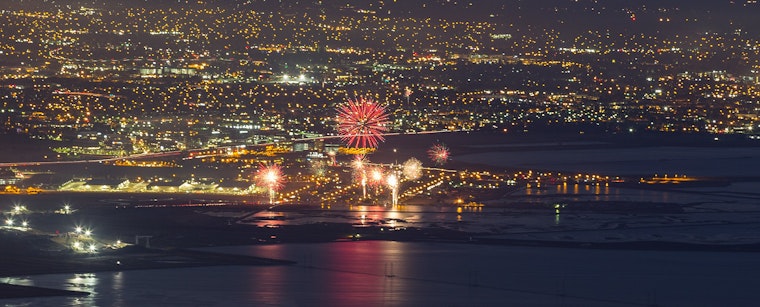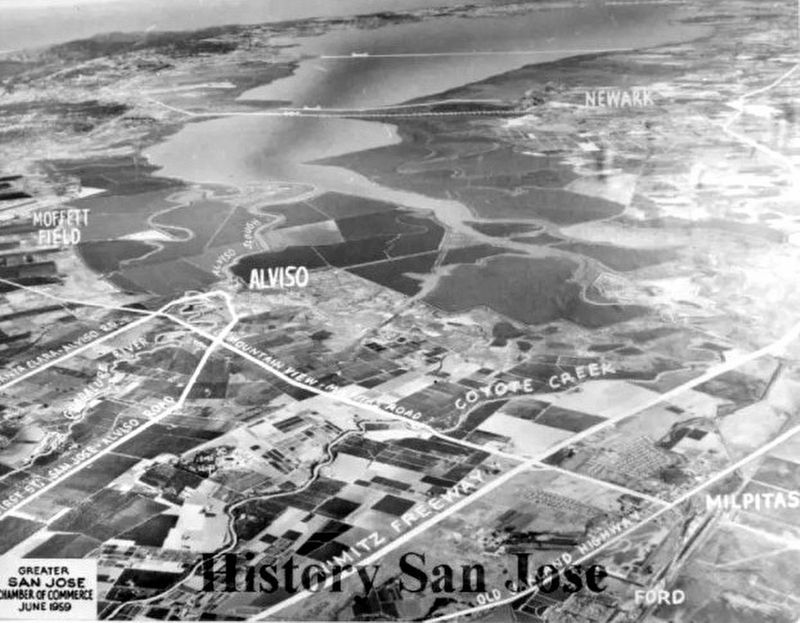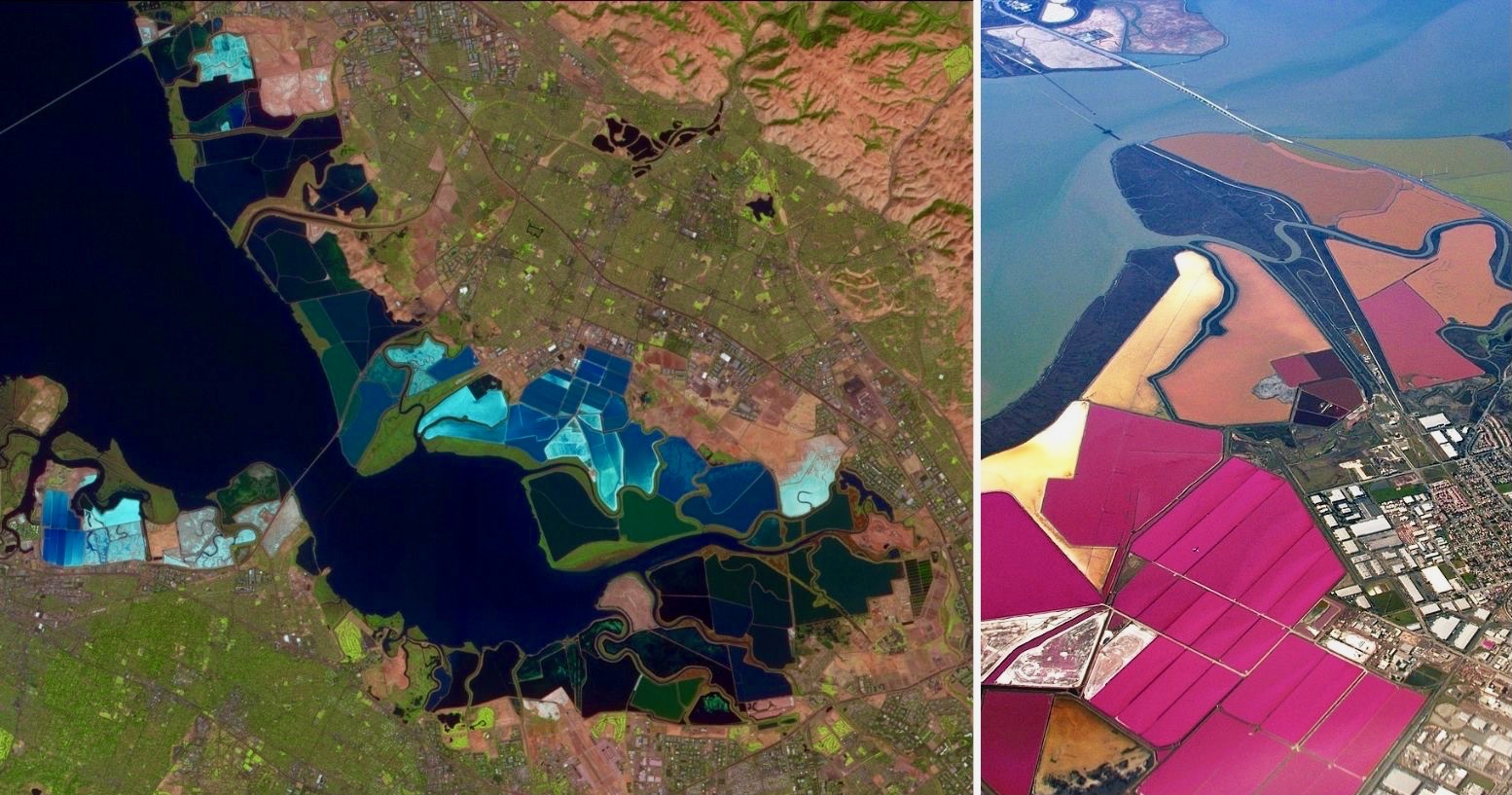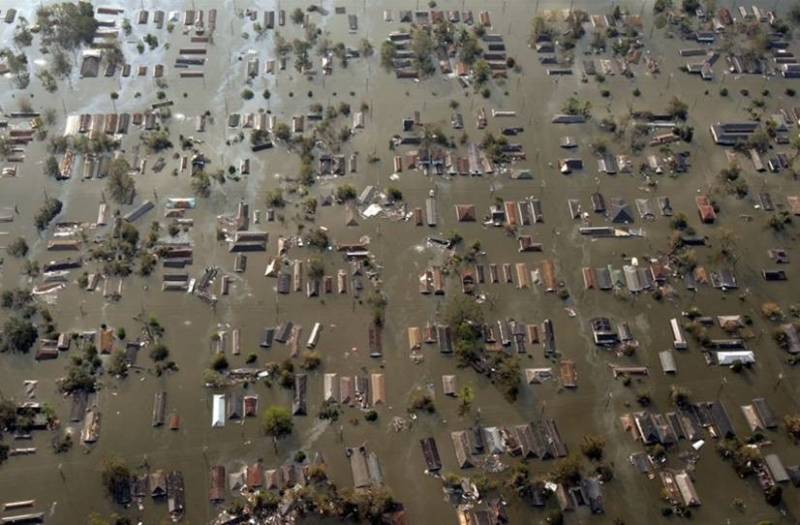
Located at the bitter end of the South Bay, the town of Alviso has long struggled with its identity. Comprising San Jose's only bay-side borders, Alviso was one of the original shipping ports on the West Coast, a bustling waterfront town serving as the main hub from Santa Clara Valley to the Central Bay in the mid-19th century — "like a South Bay version of San Francisco’s Pier 39," said one South Bay publication. As industries evolved and the Bay Area grew around it, Alviso has become emblematic of many modern coastal cities where industries long ago departed. The city of 2,000 sits 15 feet below sea level, and is susceptible to flooding. And last summer, one of Alvio's historic but neglected buildings, which was likely being occupied by unhoused people, was destroyed by a fire.
And then there's that identity problem. One San Jose councilmember called Alviso "the forgotten stepchild of the city," where residents have been fighting to preserve Alviso's historic, pre-Civil War character. (When Googling Alviso, one of the "People Also Ask" prompts says, "What happened to Alviso?")
But Alviso's abundant acres of tidal marshlands and former commercial salt ponds — which far exceed its acreage of terra firma — are slowly being reclaimed and restored. In 1979, the first urban National Wildlife Refuge was established in Alviso. In 2003, state and federal wildlife agencies acquired 15,100 acres of South Bay salt pond properties in Alviso, Union City, and Menlo Park, launching the 50-year effort South Bay Salt Pond Restoration Project, the largest wetland restoration project on the West Coast, according to the Mercury News.
Slowly but surely, Alviso continues to find itself.
 The borders of the South Bay, as seen in 1959. Alviso is perched south of the Dumbarton Bridge. Source: History of San Jose
The borders of the South Bay, as seen in 1959. Alviso is perched south of the Dumbarton Bridge. Source: History of San Jose
 All but hidden unless you have the benefit of elevation, the commercial salt ponds of the South Bay have been a colorful mosaic that has defined the bottom section of San Francisco Bay. Alviso's salt ponds have been slowly surrendered to ecological efforts, and are now part of a massive restoration project. Cargill Salt continues operations in Newark, on the east side of the bay. "The Cargill plant is capable of crystallizing 500,000 tons of sea salt each year," the Mercury News said. Sources: Right Photo: NASA Earth Observatory Left Photo: Wikiland
All but hidden unless you have the benefit of elevation, the commercial salt ponds of the South Bay have been a colorful mosaic that has defined the bottom section of San Francisco Bay. Alviso's salt ponds have been slowly surrendered to ecological efforts, and are now part of a massive restoration project. Cargill Salt continues operations in Newark, on the east side of the bay. "The Cargill plant is capable of crystallizing 500,000 tons of sea salt each year," the Mercury News said. Sources: Right Photo: NASA Earth Observatory Left Photo: Wikiland
"What has remained the same here," San Jose Inside said of Alviso's history, "is the seasonal flooding that has been a staple of the marshland's history — from glacial meltdown forming the Bay's shape around 18,000 years ago, to slough-side Ohlone villages harvesting salt and clams for centuries, to King Tides bogging down missionaries' adobe homes in the 1700s."
Alviso has created flood-control measures for the surrounding creeks and streams, but risk of inundation from the Bay remains. It's not clear what role sea-level rise might play in the fate of the town, but it isn't likely to survive easily. Shoreline restoration projects along with salt-pond restoration are meant to work in tandem, "balancing man-made flood management engineering with nature-based mitigation solutions," San Jose Inside wrote, adding that "it's a race against the clock to get ahead of a major storm that could put the region underwater again."
South Bay restoration projects have also been incredibly expensive, and have been subsidized in part by federal funding. But the lion's share of the costs will come from 2016's Measure AA, a parcel or real-estate tax that would add $500 million to project coffers over 20 years.
 Sitting at the confluence of ponds, sloughs and waterways at the southernmost point of where South San Francisco Bay meets the Guadalupe River and Coyote Creek, Alviso is at ground zero for floods, according to San Jose Inside. During the 1983 El Nino, both the Guadalupe River and Coyote Creek overflowed into Alviso's streets, as seen above. "The town now has flood protections from these bodies of water, but is still unprotected from the San Francisco Bay," KQED reported. Source: U.S. Fish and Wildlife Service
Sitting at the confluence of ponds, sloughs and waterways at the southernmost point of where South San Francisco Bay meets the Guadalupe River and Coyote Creek, Alviso is at ground zero for floods, according to San Jose Inside. During the 1983 El Nino, both the Guadalupe River and Coyote Creek overflowed into Alviso's streets, as seen above. "The town now has flood protections from these bodies of water, but is still unprotected from the San Francisco Bay," KQED reported. Source: U.S. Fish and Wildlife Service
And what of the forgotten, neglected Alviso?
In late June last year, the historic H.G. Wade Warehouse was gutted by a fire. Prior to June, residents said that after complaining to the city of San Jose that people appeared to be squatting in the warehouse, and that a solar panel had been erected next to the building, nothing was done. The warehouse was called "one of the landmark locations of the Alviso neighborhood,” according to San Jose Spotlight. Residents said that the fire was the result of indifference from city officials, "a scandal born out of the city turning a blind eye to the problem." (Alviso "ceased to exist" [according to one historical account] when it was consolidated with the City of San Jose in 1968; the vote was 189 to 180 in favor of consolidation.)
“We have long hoped that somebody would look at that site with a little bit more creativity, and sort of be able to revitalize it in ways that Alviso desperately need[ed],” Ben Leech, the executive director of the Preservation Action Council of San Jose, told Spotlight. Leech also said that losses of historic buildings in San Jose are not uncommon; fire heavily damaged the 125-year-old Lawrence Hotel just a few months ago, and a conflagration destroyed IBM’s historic Building 25 in 2008. Experts say that other historic structures in Alviso have been preserved, but not always maintained.
 The Harry George Wade’s Warehouse, before it was damaged beyond repair in June, 2021. The warehouse was "originally used to store hay and grain bound for San Francisco," according to Historical Marker Database. "It was later used to store stagecoaches for the Alviso to Monterey stage lines; the warehouse also served as a set for Western Movies." Source: Historical Marker Database/Syd Whittle
The Harry George Wade’s Warehouse, before it was damaged beyond repair in June, 2021. The warehouse was "originally used to store hay and grain bound for San Francisco," according to Historical Marker Database. "It was later used to store stagecoaches for the Alviso to Monterey stage lines; the warehouse also served as a set for Western Movies." Source: Historical Marker Database/Syd Whittle
Moving into the future, Alviso is the new home to Topgolf, an ultra-modern golf club and entertainment venue, which hopes to bring half-a-million people a year to the "forgotten stepchild" of San Jose. Alviso has seen some slow revitalization in recent years, San Jose Spotlight reported, "with companies such as Dell and TiVo opening offices south of the historic downtown, and tech giants HP and Google choosing Alviso for more San Jose-based offices."
But across the street from the new Topgolf facility, skeletons of Alviso's past and uncertain future remain, such as abandoned homes and empty streets. David Cohen, a San Jose city councilmember whose district includes Alviso, tells San Jose Spotlight, "I've spent a significant amount of time in the Alviso community. I’ve toured many of the problem-areas with local leaders and residents, and I’ve been working with my staff to create solutions with city departments."
Cohen adds, “It’s no secret that the residents of Alviso have felt neglected.”









